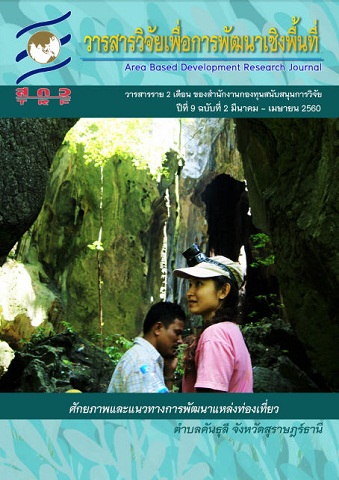การจัดการตลาดการท่องเที่ยวโดยชุมชนของแหล่งมรดกทางวัฒนธรรมลุ่มน้ำโขง ชี มูล เพื่อเชื่อมโยงการท่องเที่ยว ประเทศไทย ลาว และ เวียดนาม
Main Article Content
Abstract
งานวิจัยนี้มีวัตถุประสงค์ เพื่อ 1) ยกระดับขีดความสามารถและกลไกทางการตลาดการท่องเที่ยวโดยชุมชน 2) พัฒนา ศักยภาพและความสามารถด้านทรัพยากรมนุษย์ของเครือข่ายการท่องเที่ยวโดยชุมชนในการจัดการตลาดการท่องเที่ยวด้วยตนเอง 3) สร้างกระบวนการมีส่วนร่วมของชุมชนกับการจัดการตลาดการท่องเที่ยวโดยชุมชนของแหล่งมรดกวัฒนธรรมภาคตะวันออกเฉียงเหนือ และ 4) ศึกษาพฤติกรรม ความต้องการ ปัจจัยที่ส่งผลต่อการตัดสินใจเดินทางท่องเที่ยวและสร้างภาพลักษณ์ทางการท่องเที่ยวโดยชุมชน ในการรับรู้ของนักท่องเที่ยวไทย ลาว เวียดนาม และต่างประเทศ งานวิจัยใช้วิธีการวิจัยแบบผสม (Mixed methods) โดยอาศัยกระบวนการมีส่วนร่วมของชุมชนในการดำเนินการวิจัย และมีการลงพื้นที่สำรวจภาคสนาม การสัมภาษณ์เชิงลึก การจัดเวทีสนทนากลุ่ม และการเก็บข้อมูลโดยใช้แบบสอบถามกับนักท่องเที่ยว ประชากรและกลุ่มตัวอย่าง 3 กลุ่ม ได้แก่ 1) นักท่องเที่ยวชาวไทย 400 ตัวอย่าง ลาวและเวียดนาม ประเทศละ 100 ตัวอย่าง และนักท่องเที่ยวชาติอื่นๆ 200 ตัวอย่าง รวม 800 ตัวอย่าง 2) ชุมชนและสมาชิกในชุมชนท่องเที่ยวจำนวน 75 ชุมชน ในขั้นตอนการสำรวจข้อมูลสภาพและปัญหาการดำเนินงานด้านการตลาดและเครือข่ายและ 3) สมาชิกกลุ่มท่องเที่ยวโดยชุมชน จำนวน 20 ชุมชน ที่เข้าร่วมกระบวนการในการวิจัยเชิงปฏิบัติการ เพื่อยกระดับขีดความสามารถ กลไกทางการตลาด และการพัฒนาศักยภาพด้านทรัพยากรมนุษย์ รวมถึงการสร้างกระบวนการมีส่วนร่วมของชุมชนกับการท่องเที่ยว จากการวิจัย พบว่า ชุมชนมีศักยภาพด้านการตลาดในระดับที่สูงขึ้น นอกจากนี้สมาชิกในเครือข่ายเกิดการพัฒนาใน 2 มิติ คือ มิติกลไกเครือข่ายการจัดการตลาด โดยเกิดเป็นเครือข่ายการท่องเที่ยวโดยชุมชนภาคตะวันออกเฉียงเหนือ 1 เครือข่าย และมีแผนการดำเนินงานของเครือข่าย ในมิติของการพัฒนาศักยภาพด้านการตลาด มีการกำหนดวิสัยทัศน์ทางการตลาดร่วมกันของเครือข่าย คือ “เป็นแหล่งท่องเที่ยวที่สะท้อนอัตลักษณ์และเอกลักษณ์ของทรัพยากรของภาคตะวันออกเฉียงเหนือและท้องถิ่น ได้แก่ วิถีวัฒนธรรมอีสาน ความบริสุทธิ์ของคนอีสาน ที่สามารถจัดการต้อนรับผู้มาเยือนได้อย่างเป็นเอกลักษณ์ เหมาะสม และมีมาตรฐาน” นอกจากนี้ผลจากการวิจัยยังสามารถสร้างกระบวนการมีส่วนร่วมในลักษณะของเครือข่ายการตลาดของภาคตะวันออกเฉียงเหนือ ทำให้เกิดแผนการตลาดของเครือข่าย สำหรับผลการศึกษามิติของนักท่องเที่ยว พบว่า พฤติกรรมของนักท่องเที่ยวไทย ลาว เวียดนาม และต่างประเทศ มีความแตกต่างกัน แต่โดยส่วนใหญ่ต้องการความเป็นมิตรไมตรีและการให้บริการของคนท้องถิ่น
The Community Tourism Marketing Management based on Cultural Heritage Site of Khong-Chi-Mun River Basin for Linked Thai–Laos-Vietnam Tourism
The objectives of this research are 1) to increase community based tourism (CBT) competitiveness and mechanism of marketing management, 2) to develop CBT potential of ISAN human resources, 3) to participate of local community in marketing management, 4) to study the tourist behavior and need and tourist perception toward the CBT on cultural heritage, and 5) to find out the guidelines for development of the destination image and to develop the strategies for the image communication of the CBT. This research employed both quantitative and qualitative research. The research populations of Thai, Laos, Vietnamese, international tourists are respectively 400, 200, 100 and 100 samples as well as local community members of CBT in north eastern region. For the qualitative research, the researcher collected data of 75 CBT villages and 20 CBT villages for the participation action research process. To increase the competitiveness and marketing mechanism of CBT based on Cultural Heritage of Khong-Chi–Mun River Basin in North Eastern Region of Thailand, the CBT cluster and networking are developed to increase potential, knowledge, understanding in marketing management in middle level. The vision of CBT ISAN cluster and network plan and mechanism is “Collaborative and Cooperative for creating and increasing CBT and sustainable of community based tourism marketing management”. The vision of CBT marketing plan is “Be tourist destination in uniqueness and identity of north eastern region with is ISAN way of life and cultural, purely of ISAN local community, and satisfy tourist by provides the best welcome and service in ISAN identity way and standard”. Common tourist needs are the friendly service from the good host. Tourist behaviors of Thai, Laos, Vietnamese and international are different. For the perception of the destination image of the community based tourism in the north eastern region, The perception of Thai and foreign tourists is the friendliness of ISAN people, whereas, that of Laos tourists is ISAN cultural heritage. On the other hand, Vietnamese tourists have perception in terms of the local identity of ISAN ethnic groups.
Article Details
Area Based Development Research Journal values copyright protection and licensing to safeguard author rights and facilitate the appropriate dissemination of research. Our policies ensure openness, accessibility, and attribution. Authors retain copyright ownership, and articles are published under a Creative Commons Attribution License (CC BY), allowing sharing, adaptation, and proper attribution. Authors have the freedom to publish under the CC BY license, granting broad reuse and distribution permissions. The journal supports posting articles on third-party repositories, adhering to institutional and funding restrictions. Author guidelines detail copyright and licensing requirements, empowering authors with knowledge about their rights and responsibilities. These policies cultivate an environment of collaboration, openness, and responsible sharing, benefiting authors and the research community while honoring intellectual property rights.


